Contents
Market Overview
Macro Review
Rate markets remain stuck in a taperless tantrum. Despite a full catalogue of central bank decisions, all eyes were on the Federal Reserve last week. A revision to 6.5% growth in 2021, core PCE of 2.2% and unchanged dots in 2023 were the key takeaways. Powell’s remarks during the Q&A session reiterated a focus on actual rather than forecasted progress, which has been taken literally, in that the Fed is prioritizing full employment ahead of inflation. Deliberation around the SLR came to an end on Friday as the Fed chose to let the measure expire, although the Committee did increase the RRP size from $30bn to $80bn per counterparty as an offsetting measure. We note that volatility in ATM swaptions and U.S. Treasuries remained elevated into the quadruple witching event, while equity and FX volatility continued to trade lower. Instead the market largely ignored the BoJ policy review (and BOE/Norges), but welcomed higher rate decisions out of Brazil, Russia and Turkey. Newsflow out of Alaska was also frosty, just as third-wave concerns in Europe picked up with regional lockdowns in France and Italy, however neither headline in isolation was responsible for the decline in oil by 7% on the week. Instead CTA flows were the active agent last Thursday, pushing U.S. Treasury yields higher and oil futures lower.
EM Credit Update
EM Credit ended the week up 0.2% with spreads 8bp and 6bp tighter across EM Sovereign and EM Corporate Credit, respectively. At the sovereign-level, Ecuador, Argentina and Suriname outperformed this week, while Georgia, Jordan and Zambia lagged. One factor that stood out this week was the bid for EM duration, where the EMBI segment of the index that is greater than >10yrs generated returns of 0.23% just as the UST 30yr widened 8bp to 2.45%. We continue to believe that duration can offer investors a significant opportunity to capture alpha in 2021 over narrow trading horizons.
The Week Ahead
After Brazil, Russia and Turkey hiked rates by 75bp, 25bp and 200bp, the market is beginning to question whether this is the beginning of the EM tightening cycle. Rate decisions out of South Africa and Mexico will likely take a larger focus at least over China (3.85%), Czech Republic (2.0%), Colombia (1.75%), Ghana (14.50%), Hungary (0.60%), Nigeria (11.50%), Philippines (2.0%) and Thailand (0.50%). Brazil Copom’s minutes and inflation report are also due, although the BCB have already guided another 75bp hike at the May meeting. The Lunar New Year and base effects will continue to lead to some data volatility in Asia. It is likely that Hong Kong exports remain high, just as Singapore’s industrial production expands further. However, base effects will eat into Hong Kong’s CPI print that is expected to decline from 1.9%, while continuing to increase from low levels in Singapore and Malaysia.
This week’s emerging markets highlights discussed below include: U.S. / China high-level meetings re-emphasized key areas of focus for the U.S. – both sides publically flexed muscles; U.S. sanctions on Russian sovereign debt and/or globally significant economic sectors remain unlikely, despite rapid deterioration in the bilateral relationship; The Central Banks of Turkey, Brazil and Russia delivered hawkish surprises amid more challenging global macro backdrop and domestic inflation outlooks; and Paraguay’s President avoids impeachment motion.
Fixed Income
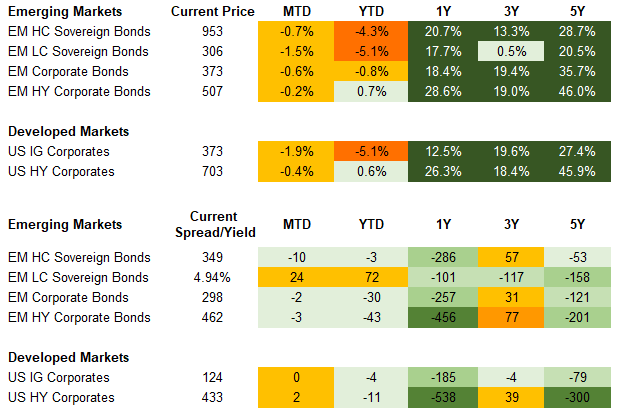
Equities
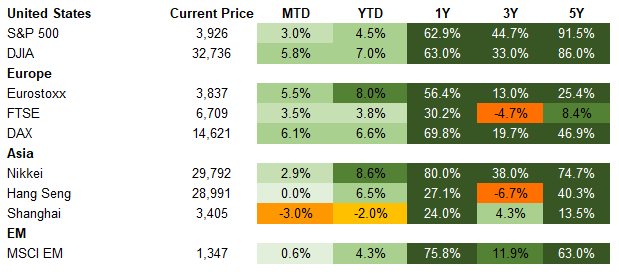
Commodities

Source for data tables: Bloomberg, JPMorgan, Gramercy. EM Fixed Income is represented by the following JPMorgan Indicies: EMBI Global, GBI-EM Global Diversified, CEMBI Broad Diversified and CEMBI Broad High Yield. DM Fixed Income is represented by the JPMorgan JULI Total Return Index and Domestic High Yield Index. Fixed Income, Equity and Commodity data is as of March 19, 2021 (Mid Afternoon).
Emerging Markets Weekly Highlights
U.S.-China high-level meetings re-emphasized key areas of focus for the U.S.; both sides publicly flexed muscles
Event: This week, U.S. Secretary of State, Antony Blinken and U.S. National Security Advisor, Jake Sullivan held the Biden Administration’s first in-person meeting with Chinese officials, including Politburo Member, Yang Jiechi and China Foreign Minister, Wang Yi in Alaska. At the time of writing, the discussions were reported as tense at moments and centered around a wide range of topics, including areas of human rights and technology, but did not yield tangible outcomes.
Gramercy Commentary: The conversations were generally in line with expectations for continuation of the tough narrative of efforts to align Chinese behavior with U.S. interests and did not contain specific measures or actions. While each side’s demonstrations of strength are authentic and meaningful, the still comparatively more diplomatic approach of the new U.S. administration should reduce the immediate market relevance of such events particularly in the still early stages of review of overall China strategy. The announcement of sanctions on Chinese and Hong Kong officials and tightened technology sector related restrictions ahead of the meetings and movement in Congress on China-related bills that support greater spending on research and development in key technology related sectors as well as rare earth materials point to a multi-faceted strategy of targeted defensive and offensive measures. We will be watching for the official read out on the private discussions after the conclusion of the meetings on Friday, particularly related to geopolitical matters such as North Korea, Iranian oil imports, and the South China Sea. Looking forward, Xi and Biden may hold their first in person meeting at a climate summit in April while White House reviews of China policy are expected in late May.
U.S. sanctions on Russian sovereign debt and/or globally significant economic sectors remain unlikely, despite rapid deterioration in the bilateral relationship
Event: Market noise around the ever-present risk of U.S. sanctions on Russia intensified again this week, following the release of a declassified intelligence report detailing alleged Russian interference in the 2020 U.S. election and some strongly worded messages by President Biden.
Gramercy Commentary: Recent deterioration in the U.S.-Russia bilateral relationship increases domestic political pressure on the Biden Administration to take a “tough stance” against Moscow. In an environment like this, we expect a package of retaliatory measures to materialize in the near future and we think that new economic sanctions will likely be part of it. Although we think new sanctions against Russian entities/persons are probable, we remain of the view that such measures are likely to be designed in a way that minimizes the negative spillover effects in markets and on U.S. economic agents. Deploying the “nuclear option” of targeting local currency debt (OFZ) and/or secondary trading of USD-denominated Russian bonds remains unlikely, in our view. If such material measures were to be considered at some point in the future, they would likely follow a significant escalation in tensions and as such, should be well telegraphed to markets. As a reminder, in relation to the 2019 “Skripal Case” the U.S. mandated restrictions on direct (primary) issuance by banks under U.S. jurisdiction of non-RUB denominated Russian sovereign debt, but stopped short of imposing more meaningful sanctions on secondary trading and/or RUB-denominated debt. As such, a step in that direction would represent a major escalation that will likely have a material negative impact on U.S. market participants, which is something the Biden Administration would prefer to avoid, in our view.
The Central Banks of Turkey, Brazil and Russia delivered hawkish surprises amid more challenging global macro backdrop and domestic inflation outlooks
Event: This week the central bank of Turkey (CBRT) hiked its policy rate by 200 bps to 19%, its Brazilian counterpart (BCB) increased the SELIC rate by 75 bps to 2.75% and the Bank of Russia (CBR) delivered a 25 bps hike to 4.50%. Market consensus expected 100 bps, 50 bps, and on hold, respectively.
Gramercy Commentary: The hawkish surprises by three major EM Central Banks signal to us a preference by policymakers to err on the side of doing “more and earlier” in terms of tightening of monetary policy in the face of a volatile DM interest rate environment and increasing uncertainty on domestic inflation outlooks. As we wrote recently, for the CBRT in particular, this month’s monetary policy meeting was yet another crucial test for Governor Agbal and his team’s market credentials, given the policy credibility deficit accumulated by their predecessors in the recent past. By over-delivering, the CBRT passed the market test with excellence, in our view. It has also built a comfortable real rates buffer in the event inflation overshoots before likely peaking by April/May. The positive credibility shock and tight monetary policy stance by the CBRT are positive catalysts for Turkish assets in general and the currency (TRY) in particular. However, a resumption of TRY’s impressive rally against the USD will likely require some of the recent global headwinds emanating from volatile DM rates and higher commodity prices to subside. As for Brazil, the COPOM also delivered more than markets expected and clearly guided toward another 75 bps hike in May unless there is a “significant change” in the inflation outlook and/or the balance of risks in the Brazilian economy. Brazil is facing a confluence of fiscal, political and public health challenges at the moment that cloud the macroeconomic outlook, as highlighted by the BCB. All else being equal, tightening of monetary policy should help the battered BRL recover some lost ground. However, investors will also be looking for an improving fiscal trajectory and prospects for a stronger economic recovery in the second half of the year. Looking further ahead, policymakers in Brazil will face a challenging election year environment in 2022, further complicated by former President Lula’s recent release from jail and political rehabilitation. In Russia, the earlier than expected start of a monetary policy normalization cycle reflects higher near-term uncertainty related to the Fed policy outlook, but also increasing noise around geopolitical risks (i.e. U.S. sanctions/relations with the U.S. under Biden) and prospects for more robust government spending going forward from Russia’s abundant fiscal resources.
Paraguay’s President avoids impeachment motion
Event: Protests over the past two weeks due to discontent with the government’s handling of COVID-19 and vaccine management led to opposition calls for impeachment of President Mario Abdo Benitez and Vice President Hugo Velazquez. On Wednesday, Congress voted against the motion 42 to 36 allowing Abdo Benitez to avoid a Senate trial. The Administration also imposed new curfews this week amid increased pressure on the health system.
Gramercy Commentary: The situation will likely remain fluid and challenging amid the current virus wave, but protests have eased for the time being. The comparatively constructive macroeconomic backdrop outlined in the IMF’s Article IV published earlier this month with growth recovering to 4.5% following a 1% contraction in 2020 will face headwinds amid renewed restrictions and health system strains. However, if the authorities receive and begin to effectively distribute vaccine supplies from the WHO this month (100k) and Russia (1mm) in the coming months, this should begin to partially alleviate social and economic pressure. Paraguay has endured similar political noise in the recent past with an impeachment in 2012 and an effort in the summer of 2019, albeit the unrest now is more anti-political class in nature. If the protests continue, impeachment risks may resurface, but still low debt-to-GDP levels in the mid-30s combined with relative preference for fiscal conservatism should limit price volatility, all else equal.
Emerging Markets Technicals
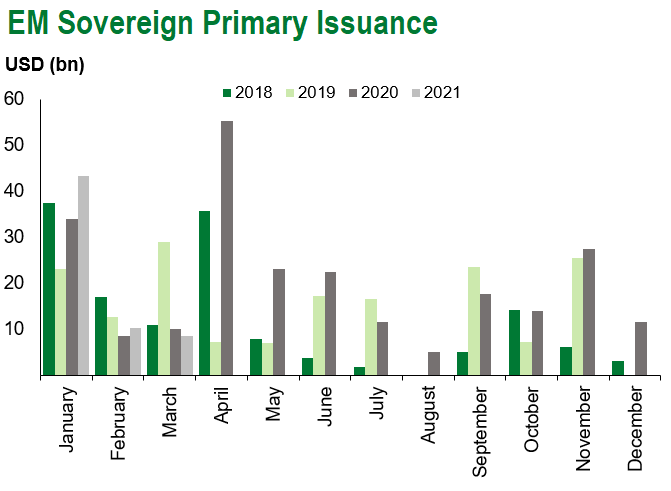
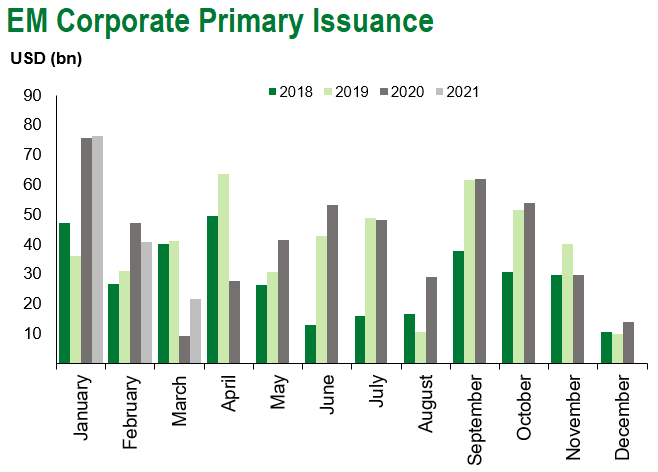
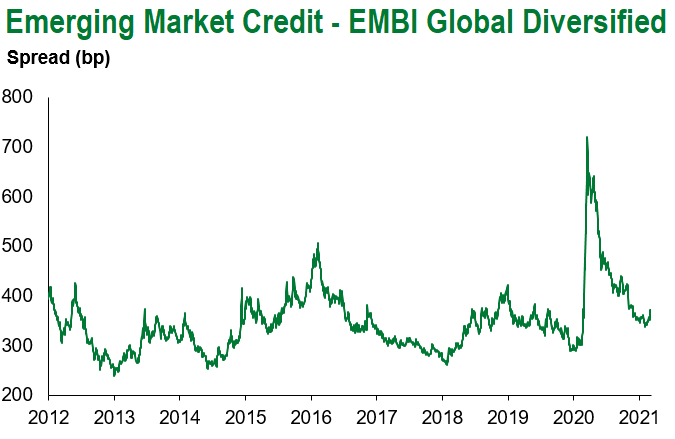

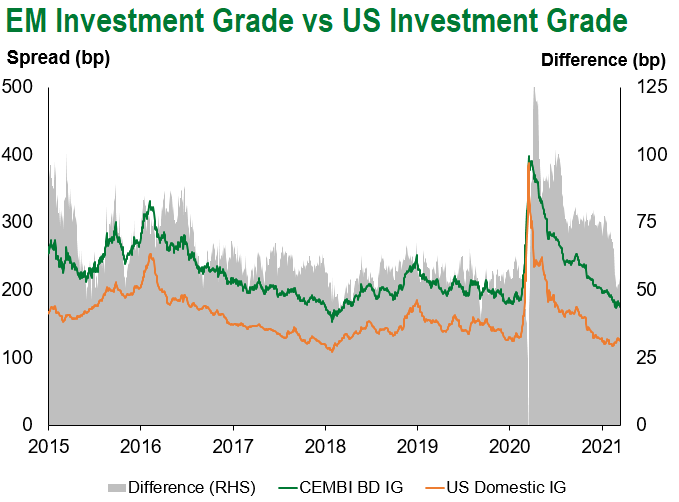
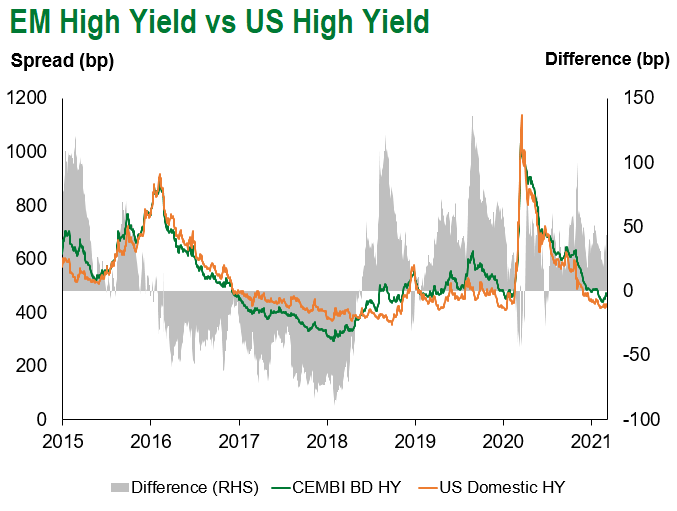
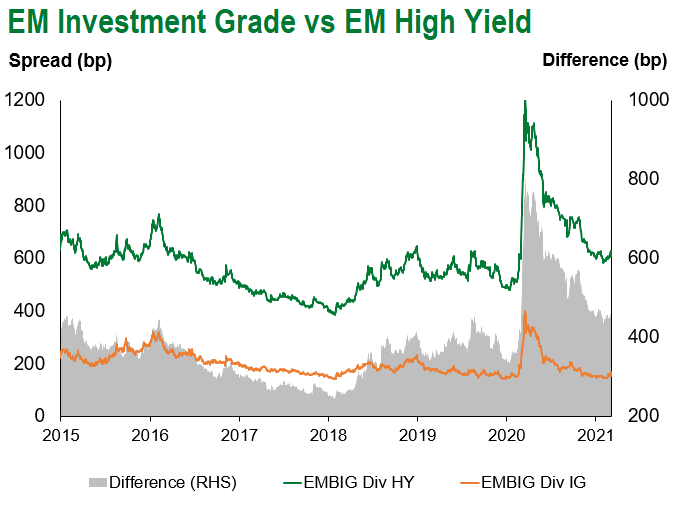
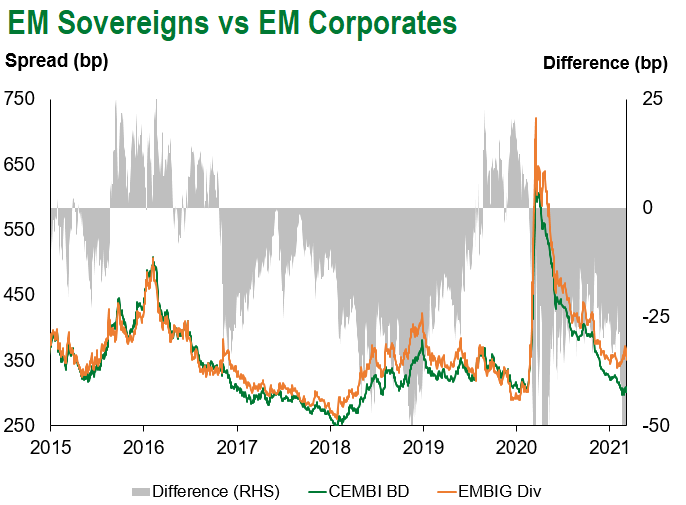
Emerging Markets Flows
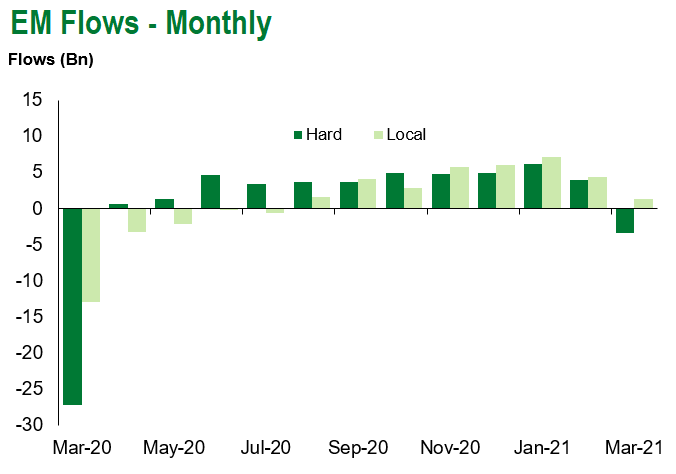
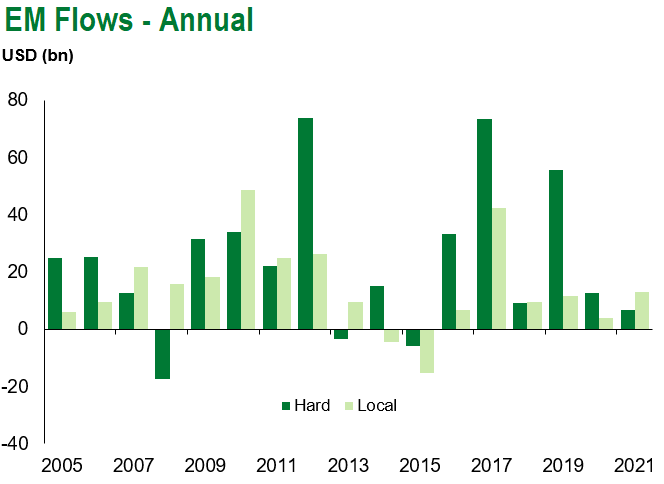
Source for graphs: Bloomberg, JPMorgan, Gramercy. As of March 19, 2021.
COVID Resources
Emerging Markets COVID-19 Case Summary
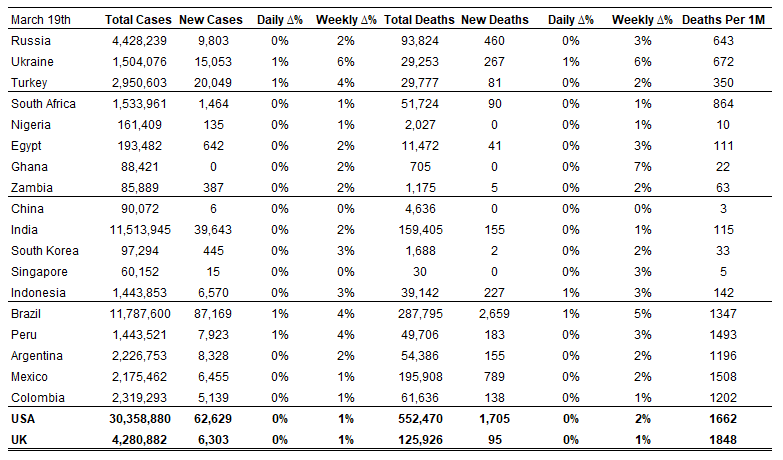
Source: Worldometer as of March 19, 2021.
Additional Crisis Resources:
Johns Hopkins COVID-19 Case Tracker
For questions, please contact:
Kathryn Exum, Senior Vice President, Sovereign Research Analyst, [email protected]
Petar Atanasov, Senior Vice President, Sovereign Research Analyst, [email protected]
Tolu Alamutu, CFA, Senior Vice President, Corporate Research Analyst, [email protected]
James Barry, Vice President, Corporate Research Analyst, [email protected]
This document is for informational purposes only. The information presented is not intended to be relied upon as a forecast, research or investment advice, and is not a recommendation, offer or solicitation to buy or sell any securities or to adopt any investment strategy. Gramercy may have current investment positions in the securities or sovereigns mentioned above. The information and opinions contained in this paper are as of the date of initial publication, derived from proprietary and nonproprietary sources deemed by Gramercy to be reliable, are not necessarily all-inclusive and are not guaranteed as to accuracy. This paper may contain “forward-looking” information that is not purely historical in nature. Such information may include, among other things, projections and forecasts. There is no guarantee that any forecasts made will come to pass. Reliance upon information in this paper is at the sole discretion of the reader. You should not rely on this presentation as the basis upon which to make an investment decision. Investment involves risk. There can be no assurance that investment objectives will be achieved. Investors must be prepared to bear the risk of a total loss of their investment. These risks are often heightened for investments in emerging/developing markets or smaller capital markets. International investing involves risks, including risks related to foreign currency, limited liquidity, less government regulation, and the possibility of substantial volatility due to adverse political, economic or other developments. The information provided herein is neither tax nor legal advice. Investors should speak to their tax professional for specific information regarding their tax situation.